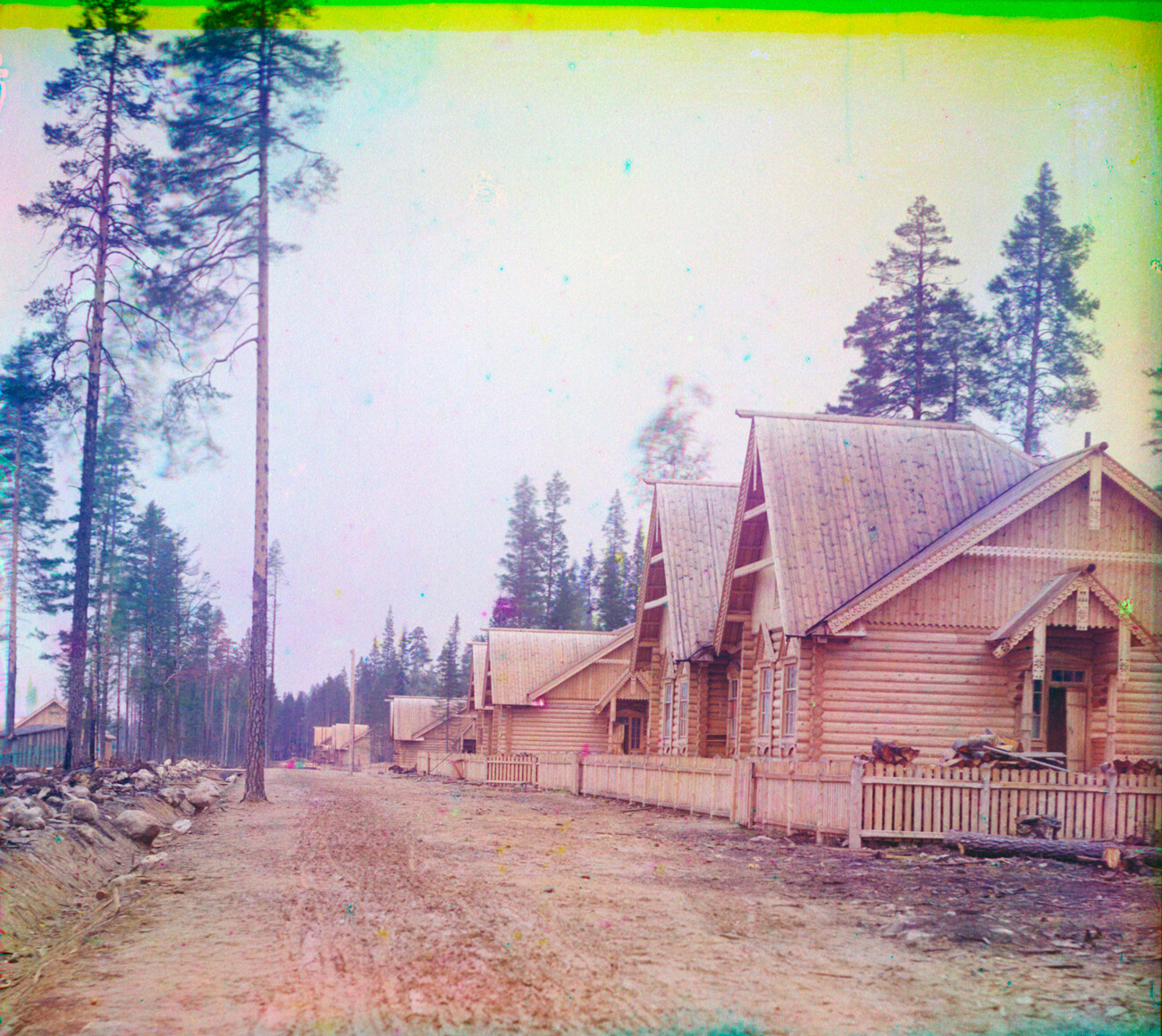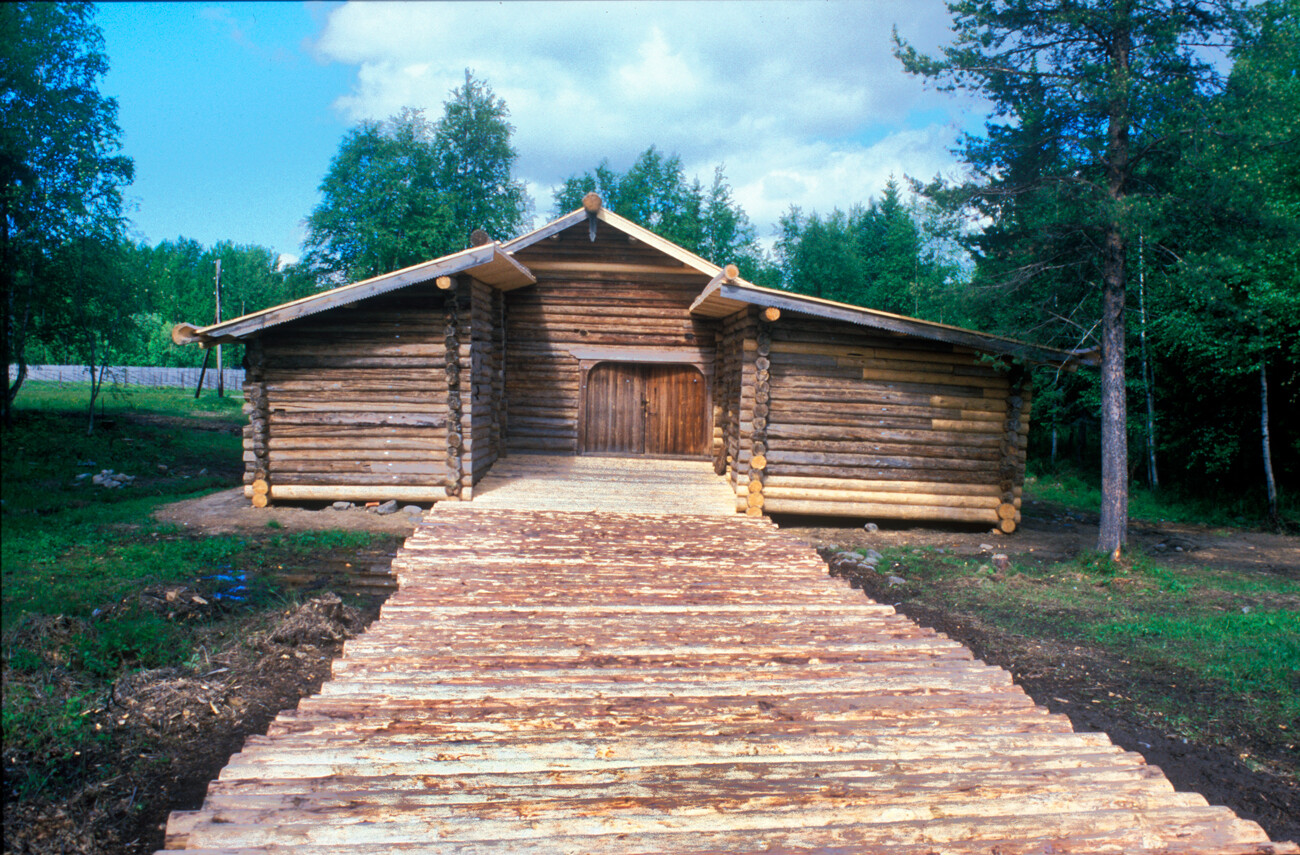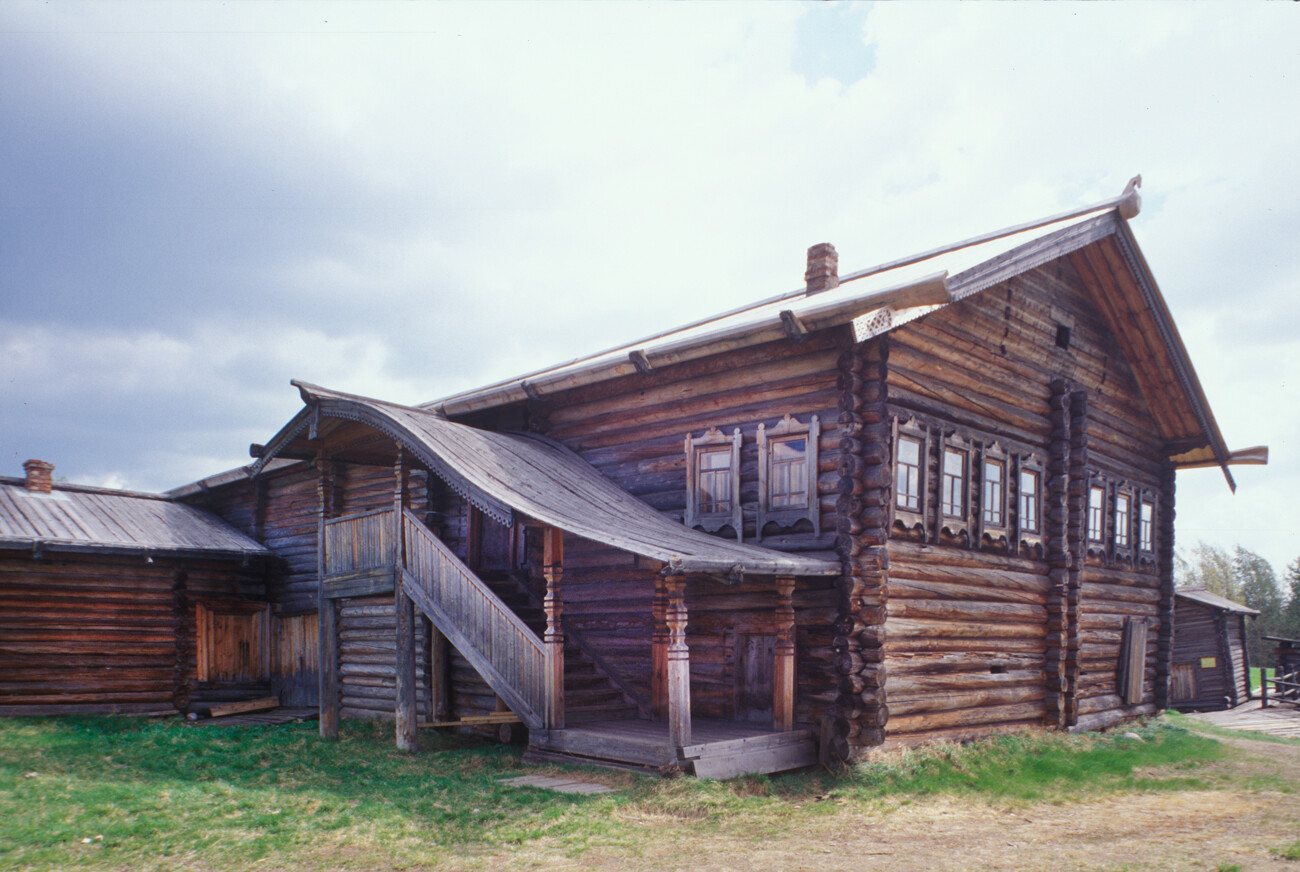Malye Korely: A window to the heritage of the Russian North

 Malye Korely. Pukhov house, originally built in Bolshoi Khalui village, Kargopol District. Low door opens to corridor between two log walls. The ground level contained winter quarters & larder. The upper level was used in warmer months. Ramp to attached barn visible at back on left. June 9, 1998
Malye Korely. Pukhov house, originally built in Bolshoi Khalui village, Kargopol District. Low door opens to corridor between two log walls. The ground level contained winter quarters & larder. The upper level was used in warmer months. Ramp to attached barn visible at back on left. June 9, 1998
At the beginning of the 20th century, Russian chemist and photographer Sergey Prokudin-Gorsky developed a complex process for vivid, detailed color photography. Inspired to use this new method to record the diversity of the Russian Empire, he photographed numerous historic sites during the decade before the abdication of Nicholas II in 1917.
 Maselskaya Station. Row of new log houses behind railroad station. Summer 1916
Maselskaya Station. Row of new log houses behind railroad station. Summer 1916
Prokudin-Gorsky’s final expedition took place in the historic Russian North during the late Summer of 1916 as the Great War raged in Europe. His special passage during these difficult times was enabled by a state commission to photograph railroad construction north along the White Sea to the new port of Murman (now Murmansk), developed at the northwestern corner of the Kola peninsula to receive Western military supplies for the hard-pressed Russian armies.
 Malye Korely. Kirillov house, originally built in Kiselyovo village, Kargopol District. Back view with ramp to barn attached along side the main house. Farm animals kept on ground level of barn. Large posts ensured stability when rotted logs on ground level needed to be replaced. June 21, 2003
Malye Korely. Kirillov house, originally built in Kiselyovo village, Kargopol District. Back view with ramp to barn attached along side the main house. Farm animals kept on ground level of barn. Large posts ensured stability when rotted logs on ground level needed to be replaced. June 21, 2003
Maselskaya Station
 Windmill with rotating top originally built at Kozhposyolok village, Onega District. June 21, 2003
Windmill with rotating top originally built at Kozhposyolok village, Onega District. June 21, 2003
Among the stations photographed by Prokudin-Gorsky was Maselskaya, built as a large depot north of Petrozavodsk. His two views include the new station building and a row of houses behind. The use of standardized designs permitted rapid construction and, yet, the buildings were notable for their use of stout pine logs to create well-proportioned functional forms with traditional detailing.
 Threshing barn from Borosvid village, Kargopol District. Corduroy log path supported wagons on approach to barn. June 21, 2003
Threshing barn from Borosvid village, Kargopol District. Corduroy log path supported wagons on approach to barn. June 21, 2003
In the aftermath of World War II and with decreasing local population, the Maselskaya Station that Prokudin-Gorsky had photographed ceased to exist. However, the flair for log construction seen in his photographs is part of a deeply rooted practice in the Russian North.
 Popov house from Pogost village, Kargopol District. Barn attached at back with ramp leading up to hay & implement storage. June 21, 2003
Popov house from Pogost village, Kargopol District. Barn attached at back with ramp leading up to hay & implement storage. June 21, 2003
Fortunately, excellent examples of large northern log houses (izba in Russian) have survived, particularly in remote villages, such as Kimzha near the Arctic Circle. For the wider public, traditional log buildings are on display in well-planned outdoor museum parks.
 Log Church of the Ascension, originally built at Kushereka village, Onega District. Left: Southeast view with apse containing main altar on right. June 9, 1998.
Right: Southwest view with vestibule. December 30, 1998
Log Church of the Ascension, originally built at Kushereka village, Onega District. Left: Southeast view with apse containing main altar on right. June 9, 1998.
Right: Southwest view with vestibule. December 30, 1998
With the advent of the summer months, visitors descend on these popular outdoor settings, whose appeal combines the beauty of traditional design with frequent festivals and displays of folk crafts.
Malye Korely
 Left: Log bell tower at Church of the Ascension, Kushereka village. June 21, 2003.
Rigth: Log bell tower from Kuliga-Drakovanovo village, Krasnoborsk district. June 22, 1999
Left: Log bell tower at Church of the Ascension, Kushereka village. June 21, 2003.
Rigth: Log bell tower from Kuliga-Drakovanovo village, Krasnoborsk district. June 22, 1999
One of the largest such outdoor museums is Malye Korely, located on high bluffs overlooking the Northern Dvina River some 25 km to the south of the city of Arkhangelsk (population around 350,000). The southern boundary of the museum is the small Korelka River, which flows into the Dvina and gives the park its name.
 Chapel of Elijah the Prophet, originally built at Mamonov Ostrov village, Plesetsk District. June 9, 1998
Chapel of Elijah the Prophet, originally built at Mamonov Ostrov village, Plesetsk District. June 9, 1998
Opened to the public in the summer of 1973, Malye Korely is far removed from the more accessible Golden Ring destinations such as Suzdal and Novgorod, both of which have their own museums of wooden architecture such as Vitoslavlitsy. Nonetheless, cruise ships dock at Arkhangelsk in the summer, and many tourists visit the Malye Korely park.
 Winter view of Chapel of Elijah the Prophet, from Mamonov Ostrov village. December 30, 1998
Winter view of Chapel of Elijah the Prophet, from Mamonov Ostrov village. December 30, 1998
The layout
 Log watermill, from Shiryaikha village, Kargopol District. June 22, 1999
Log watermill, from Shiryaikha village, Kargopol District. June 22, 1999
Malye Korely is currently divided into four sectors spread over some 140 hectares of rolling forested landscape (There are plans to add two more sectors). These sectors represent distinct historic parts of the vast Arkhangelsk Province. On display are wooden churches and chapels, as well as log houses and barns - and even a collection of windmills.
 Church of St. George, originally built at Vershina village, Verkhnetoima District. North view. December 30, 1998
Church of St. George, originally built at Vershina village, Verkhnetoima District. North view. December 30, 1998
Indeed, a windmill is visible from the entrance gates leading to the first sector, devoted to the western regions near the ancient town of Kargopol and scattered along the Onega River. This area served as an important trading route north to the White Sea and the Solovetsky archipelago.
 Limonnikov house, from Yolkino village, Mezen District. Ramp leads to upper barn at back of house. Small dwelling on right ("zimnik") was used during winter to conserve heat. July 27, 1998
Limonnikov house, from Yolkino village, Mezen District. Ramp leads to upper barn at back of house. Small dwelling on right ("zimnik") was used during winter to conserve heat. July 27, 1998
In the woods near the entrance are two spacious log houses from Kargopol Region: the Pukhov House, from the hamlet of Kiselyovo near Lyadiny, and the Kirillov House, from the hamlet of Big Khalui near Oshevensk. Each house provides a sense of the arrangement of interior space in these northern “fortress” dwellings, which include an attached barn in the back to protect livestock and supplies from the long winters.
 Limonnikov house, from Yolkino village, Mezen District. Front view with "zimnik" on far left. June 9, 1998
Limonnikov house, from Yolkino village, Mezen District. Front view with "zimnik" on far left. June 9, 1998
First sector
One of the striking displays in the first sector is the Church of the Ascension (with a separate bell tower) erected in the village of Kushereka in 1669. Its five cupolas rise from a flared roof with wooden shingles overlapping in a pattern known as “fish scales”. The interior had two altars. The one on the upper level was dedicated to Elijah the Prophet and to the martyr Saint Paraskeva, patroness of market day, while the lower level (heated for use throughout the year) was dedicated to the Ascension.
 Rusinov house (Old Believer farmstead) from Kondratyevskaya village, Verkhnetoima District. Example of horse head at top of ridge pole on both house & barn at back. December 30, 1998
Rusinov house (Old Believer farmstead) from Kondratyevskaya village, Verkhnetoima District. Example of horse head at top of ridge pole on both house & barn at back. December 30, 1998
No less impressive is a late 16th-century bell tower originally built in the village of Kuliga-Drakovanovo, part of Krasnoborsk Region at the southern reaches of the Dvina River. Among the oldest surviving log structures in the Russian North, the bell tower rises some 26 meters primarily on an octagonal shaft of horizontal log courses. The interior has three landings with flights of stairs leading to the open space for bells, which is sheltered by a tall “tent” roof.
 Rusinov house (Old Believer farmstead) from Kondratyevskaya village. Interior half used for meals, with brick stove on right. Living space behind cloth curtain. July 27, 1998
Rusinov house (Old Believer farmstead) from Kondratyevskaya village. Interior half used for meals, with brick stove on right. Living space behind cloth curtain. July 27, 1998
Second sector
A wooden pathway leads down a steep forested ravine to the second sector, devoted to structures from villages along the Northern Dvina River. On display are large houses that combine intricate craftsmanship with utility and strength of construction.
 Tropin house, from Semushinskaya village, Krasnoborsk District. Entrance porch on side, with ramp to upper barn level at back. December 30, 1998
Tropin house, from Semushinskaya village, Krasnoborsk District. Entrance porch on side, with ramp to upper barn level at back. December 30, 1998
The dominant feature is the Church of Saint George from the hamlet of Vershina, near Upper Toima on the right bank of the southern part of the Dvina. The church has a soaring tower roof typical of the Russian north. The interior has a partially preserved icon screen with rich baroque carving.
 Tropin house, from Semushinskaya village. Main bedroom furnished with store-bought items accessible to prosperous peasants in area along Northern Dvina River. July 27, 1998
Tropin house, from Semushinskaya village. Main bedroom furnished with store-bought items accessible to prosperous peasants in area along Northern Dvina River. July 27, 1998
Sectors 3 & 4
Adjoining the Dvina sector to the south are the smaller Pinega and Mezen sectors, named after the Pinega and Mezen rivers in the northeastern part of Arkhangelsk Province. Both sectors benefit from a picturesque setting on bluffs overlooking the Korelka River.
 Chapel of Holy Trinity, from Valtyegorskaya village, Pinega District. Northwest view. December 30, 1998
Chapel of Holy Trinity, from Valtyegorskaya village, Pinega District. Northwest view. December 30, 1998
The Pinega and Mezen sectors display several houses, including some that belonged to Old Believers, religious dissenters from the official Orthodox Church who were numerous in this part of the Russian north.
The Pinega sector also contains the lovely Chapel of the Holy Trinity, built in the early 18th century in the village of Valtyevo. This miniature grouping of entrance, vestibule, and main space is elevated high above the winter snow level. The planks of the steeply pitched roof have carved ends that cast a shadow design on the log walls. The chapel is capped with a wooden cupola and cross.
 Shchegolev house, from Irta village, Lensky District. Front view with elevated porch. Fine example of carved end boards. June 9, 1998
Shchegolev house, from Irta village, Lensky District. Front view with elevated porch. Fine example of carved end boards. June 9, 1998
From this small jewel of a chapel at the southeastern corner of the park, one can return through the park territory with its log houses and windmills, cross another wooden pathway down the ravine and return to the park entrance.
 Grain barn from Ust-Nizemye village, Leshukonsky District. Photograph: William Brumfield. June 9, 1998
Grain barn from Ust-Nizemye village, Leshukonsky District. Photograph: William Brumfield. June 9, 1998
In the early 20th century, Russian photographer Sergey Prokudin-Gorsky developed a complex process for color photography. Between 1903 and 1916, he traveled through the Russian Empire and took over 2,000 photographs with the process, which involved three exposures on a glass plate. In August 1918, he left Russia and ultimately resettled in France where he was reunited with a large part of his collection of glass negatives, as well as 13 albums of contact prints. After his death in Paris in 1944, his heirs sold the collection to the Library of Congress. In the early 21st century the Library digitized the Prokudin-Gorsky Collection and made it freely available to the global public. A few Russian websites now have versions of the collection. In 1986 the architectural historian and photographer William Brumfield organized the first exhibit of Prokudin-Gorsky photographs at the Library of Congress. Over a period of work in Russia beginning in 1970, Brumfield has photographed most of the sites visited by Prokudin-Gorsky. This series of articles juxtaposes Prokudin-Gorsky’s views of architectural monuments with photographs taken by Brumfield decades later.

